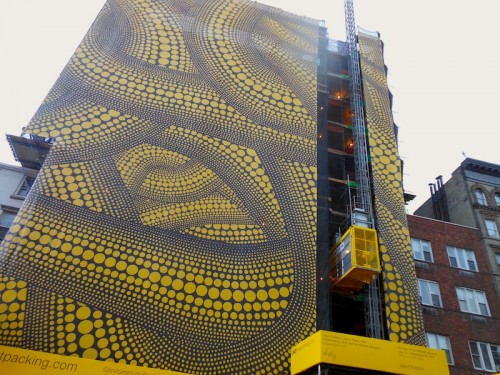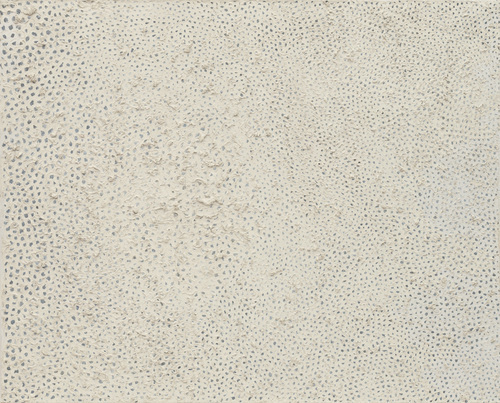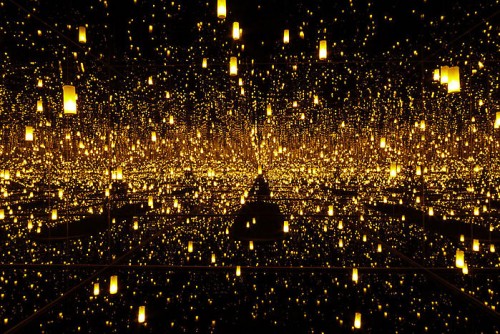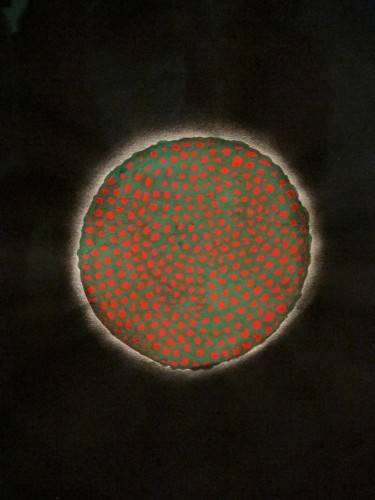During my recent visit to New York City I saw the Yayoi Kusama retrospective at the Whitney Museum of American Art. Kusama’s work brings to my mind interlace (knot) patterns, particle systems in immersive (virtual) 3D worlds and cellular cultures one might see growing in scientist’s petri dishes. I spent a lot of time staring at the endless patterns of dots in Yellow Trees (1994) which has been enlarged to envelop a building near the Whitney’s future home in the Meatpacking District. Much like a traditional Celtic knot, Yellow Trees displays a stylized graphical representation of knots made up of dots. It is the complexity of the whole piece that gives this pattern its aesthetic value and, arguably, any attempt to unravel it is to reduce its beauty. Kusama’s two-dimensional patterns on canvas can be scaled up or down and displayed on objects in countless ways, infinitely. She continually obliterates (with dots) these domestic forms and explores space as multiple universes. Through these pieces we are invited to explore her mind’s inner workings.
Yayoi Kusama’s obsessions with dots, interlace patterns, decorative and plastic spaces connect to astronomy that, as artist Dorothea Rockburne states, “combines shapes, math, metaphysics and feelings that the cosmos will continue to exist long after the lives of humankind.” Rockburne sees reality as a continuum in which human beings embody aspects of space’s vast, largely uncharted immensity, as well as contain the still-mysterious realm of subatomic particles. Matthew Ritchie and Josiah McElheny explore the idea of the universal cell or structure as part of a representational (particle) system. Kusama has recently spoken about her lifelong interest in particle systems, i.e. how “human beings are all represent dots; a single particle among billions. This is one of my important philosophies, which is accepted by many people.” Like Charles and Ray Eames’ film Powers of Ten, Kusama’s works often depict the relative scale of the universe in multiple contexts. Arts and science are similar in that they are expressions of what it is to be human in this world and Kusama’s dot-based canvases are part of the art-science ethos that, according to Cern research artist Ariane Koek is “unsubtle and still evolving.”
One large series of works featured in the retrospective explores the accumulation of smaller forms on everyday objects such as chairs, luggage, and a ladder. Kusama covered the surfaces of these objects with dry pasta and phalluses. Her obsession with the accumulation, or aggregation, of these objects depicts some of the excesses of modern (Western) life. Similarly, many biological processes involve the aggregation of forms into clusters or spaces. The particle or dot proliferates to create patterns that repeat, for example Kusama’s Infinity Net paintings (see above) place dots in layers that build depth and draw viewers in. These works explore the “multiverse,” a set of multiple possible universes that together comprise everything that exists and can exist. Since my foray into virtual 3D worlds, i.e. Second Life (SL), I have been fascinated by “particle systems” or the reduction of form to dots or circles that create alternate realities. The SL systems are often animated or controlled with a scripting language in which certain parameters can be set, such as transparency, color, brightness, etc. Kusama nearly creates the same effect in her larger installations.
Another of Yayoi Kusama’s obsessions has been the creation of large installations consisting of hundreds of low-energy LED lights reflected by wall-to-wall mirrors. Dubbed Infinity Mirror Rooms, these exhibits depict a spectacular spatial void brimming with lights. Artist Richard Serra talks about his drawings as if he were constructing virtual forms in immersive 3D space. To Serra, the drawing is something you interact with; it invites the viewer in closer, to move from being contained in the space of the room to being contained in the space of the drawing. In Kusama’s Fireflies on the Water, the visitor moves from the physical (real) space to the infinite (virtual) space of the installation. New media scholar Lev Manovich wrote in 2005,
We surely must expect profound movement in our perception of the spaces in which we live when such evolution of the spaces in which we live occurs. When spaces themselves respond to our constant interaction the mental construct that has remained relatively unchallenged for millennia will be drastically and irrevocably broken and recombined. Thus, in our cellspaces, we are in the first throes of a landslide of technological and social change that will gather momentum over the coming decade…
Perhaps without realizing it, Yayoi Kusama and other contemporary artists have created a path for new creative technologies such as immersive 3D worlds and “Augmented Spaces.” Visionary artists are the first members of a culture to see the world in a new way. Kusama shows how dots or particle systems in their more material or tangible forms can be superimposed on cultural, scientific and technological concepts to create a compelling fit. I also wanted to note the direct, or indirect connections of this kind of production with Afrofuturism, i.e. Cauleen Smith: A Star is a Seed, A Seed is a Star and Sanford Biggers’ Conundrum: The Mothership Lands at Mass MoCA. Afrofuturism (or Afro-Futurism) reflects artistic production strategies for exploring fantasies, alternate realities and histories, and new ideas about the world and the universe. Kusama’s works suggest natural phenomena (seeds, clouds, trees), and these representations are explored by contemporary artists who express their visions in artworks that obliterate their cellspaces, or identities, to return them to the infinite universe.
Yayoi Kusama is on view at the Whitney Museum of American Art through September 30.








Pingback: Sanford Biggers Studio Visit in NYC « SL Art HUD Blog Thingie:
Pingback: From Cellspace to the Universe « SL Art HUD Blog Thingie:
Pingback: Hauntologies, Ghost Nature & Magical Realism | Renegade Futurism